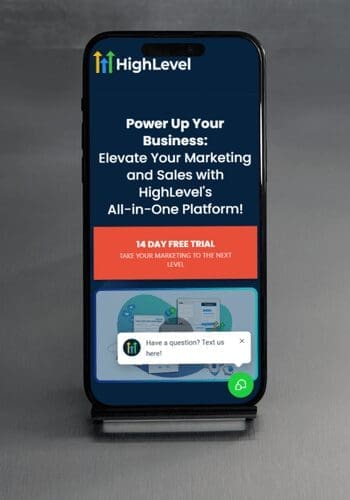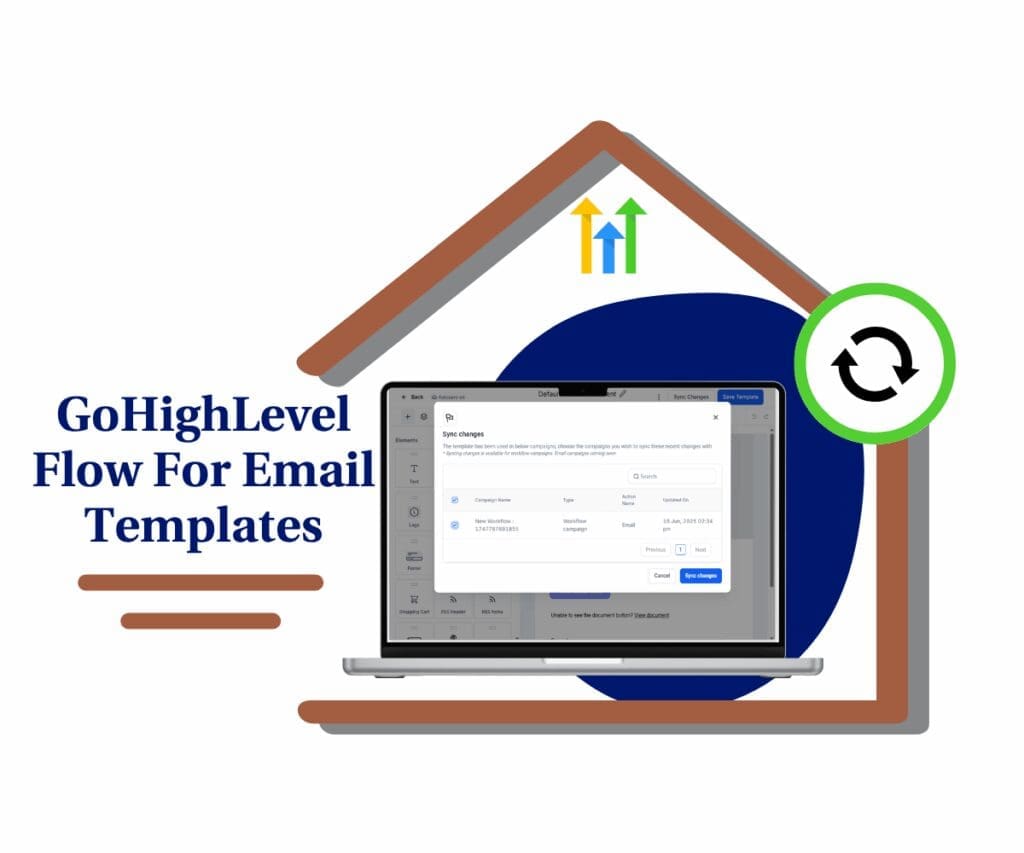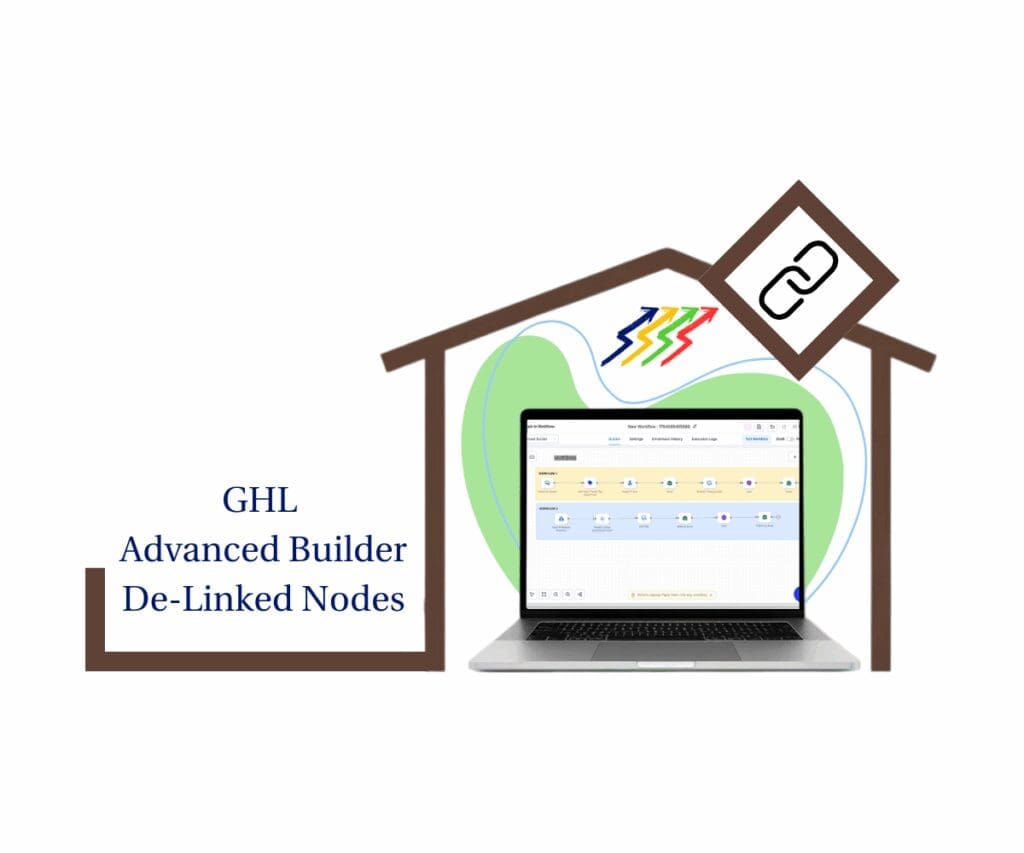- Use real-time goals for forms, payments, and docs inside GHL workflows
- Quick Summary – Workflow Goal Actions Essentials
- 3 Workflow Goal Actions Just Released
- Form Goal: Use One Goal for All Your Forms
- Payment Goal: Trigger Workflows When Money Hits
- Document Goal: Track Contracts and Proposals in Workflows
- Setting Up These Goal Actions
- Real Examples Agencies Will Love
- Smarter Automation With Less Logic
- Better Automation, Less Chaos
- Common Questions About Workflow Goal Actions
- What You Can Expect After This Update
- Try These New Workflow Goal Actions Today
Use real-time goals for forms, payments, and docs inside GHL workflows
The latest GHL update adds better workflow goal actions that make automations more flexible and easier to manage. Instead of relying on complex logic, users can now trigger goals based on real-world actions like form submissions, payments, or document activity. This change helps agencies build more direct and reliable workflows.
GHL has added three new types of goal actions: multi-form submissions, payment received or failed, and document status updates. These let users automate customer journeys with more accuracy, all inside the existing workflow builder.
This update is especially useful for agencies that want to reduce branching logic and keep their systems clean. Instead of creating separate paths for each form or contract, everything can now run through a single, smart condition.
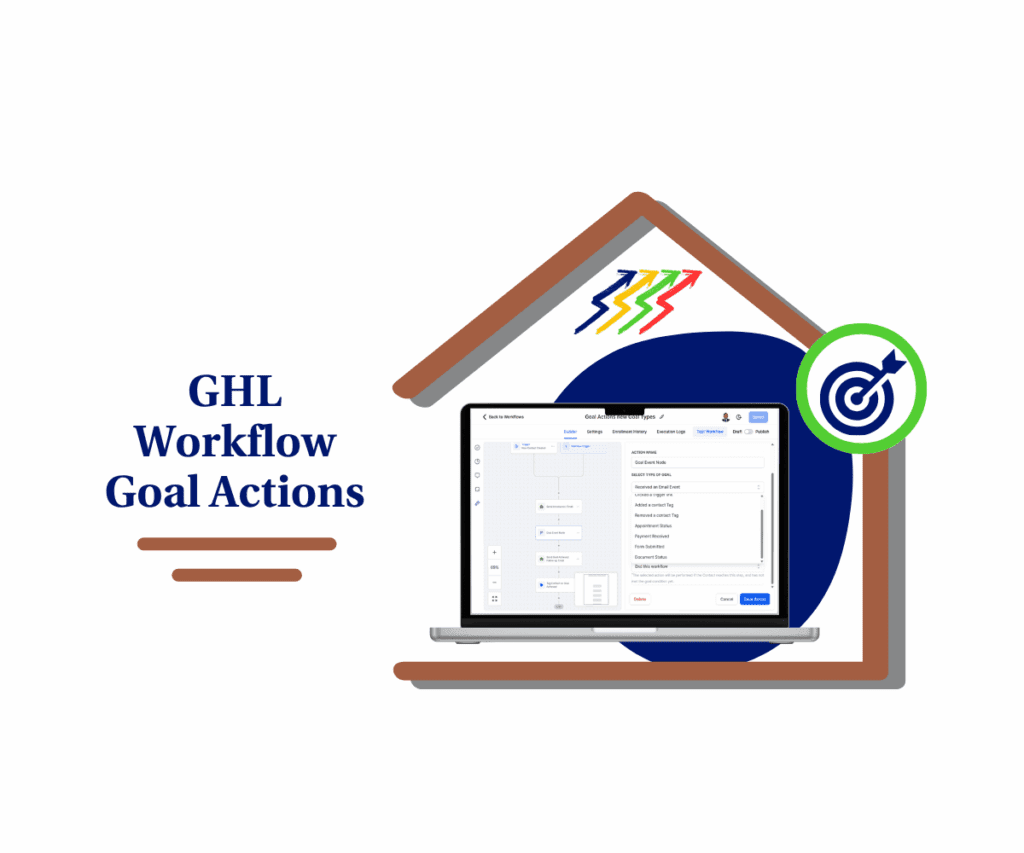
This GHL update introduces smarter workflow goal actions that let users trigger automations when contacts submit any form, make payments, or interact with documents. It’s a cleaner, faster way to automate real-life customer journeys inside workflows.
Quick Summary – Workflow Goal Actions Essentials
Purpose. GHL users can now set workflow goals based on form submissions, payments, or document activity without using extra filters or tags.
Why It Matters. This update helps teams build cleaner workflows that follow real actions instead of relying on workarounds or custom logic.
What You Get: New goal options for tracking forms, payments, and documents inside any workflow.
Time to Complete: Updating most workflows takes about 10 minutes using the new goal options.
Difficulty Level: Easy for anyone who has built workflows in GHL before. No advanced setup required.
Key Outcome: Automation runs more smoothly and reacts faster to what the contact does, which saves time and reduces errors.
3 Workflow Goal Actions Just Released
GHL has introduced three new workflow goal actions that let users track real customer activity more accurately. These additions make it easier to manage automations without building extra paths or relying on multiple triggers.
Here’s a quick look at what’s now available inside the Goal step:
Automate marketing, manage leads, and grow faster with GoHighLevel.
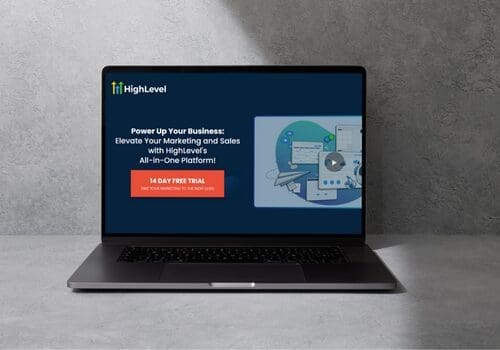
Form Submitted (Multi-Form Support)
Users can now select more than one form in a single goal. The goal is marked complete when someone fills out any of the selected forms. This is helpful for agencies that use different forms for lead magnets, webinars, or newsletters but want to keep the automation path the same.
Payment Received or Invoice Paid
A goal can now be tied to a payment event. That includes both successful and failed payments. This helps automate actions like onboarding a new client after their first payment or sending a reminder if their card fails.
Document Status (Viewed, Signed, Completed, etc.)
Workflows can now respond when a contact opens, signs, declines, or completes a document. This is useful for tracking proposals or contracts without needing a manual check-in.
Each of these new workflow goal actions is built around real events that matter to businesses. By using these directly in workflows, agencies can simplify their setup while improving the timing and accuracy of their automation.
Form Goal: Use One Goal for All Your Forms
One of the most useful parts of this GHL update is the new way form goals work inside workflows. With the improved workflow goal actions, users can now select multiple forms under a single goal. That means the workflow can continue when any of the chosen forms is submitted, without extra steps or filters.
Before this change, users had to build separate paths or use workarounds just to handle different forms. It worked, but it made things harder to manage. Now, with one goal step, the same follow-up can apply to multiple lead sources.
For example, an agency might have different forms for ebooks, checklists, or webinar signups. Instead of building a unique workflow for each one, they can now run all those leads into the same sequence. This makes updates easier and reduces the risk of errors.
This new approach saves time and keeps workflows cleaner. It also helps teams stay organized when managing campaigns across several funnels. With better workflow goal actions, there’s no need to over complicate the setup.
Payment Goal: Trigger Workflows When Money Hits
The updated workflow goal actions now include payment-based goals. This means a workflow can move forward when a contact completes a payment or when a payment fails. It gives users a simple way to automate follow-ups tied directly to billing events.
Inside the workflow builder, there’s a new goal option called “Payment Received or Invoice Paid.” Users can filter by product, amount, or payment status. When the system sees a payment that matches those filters, the goal is marked complete and the automation continues.
This is especially useful for agencies managing onboarding or billing reminders. A new client can be added to a welcome sequence as soon as their first payment goes through. If a payment fails, the system can trigger a message or task to follow up.
Before this update, teams had to rely on tags, custom triggers, or third-party tools to handle payments in workflows. Now it’s built in, and it works without extra setup. These workflow goal actions help agencies connect sales activity directly to the rest of the customer journey.
It’s one less thing to track manually, and it keeps clients moving through the right steps at the right time.
Document Goal: Track Contracts and Proposals in Workflows
GHL now gives users a way to track document activity inside workflows. With the updated workflow goal actions, it’s possible to set a goal based on what happens to a proposal or contract. This helps automate follow-ups without having to check the status manually.
Inside the goal step, users can choose from document statuses like Viewed, Signed, Completed, Declined, or Sent. When the system sees a match, the goal is complete and the workflow moves forward. Users can also filter by document template if they want to focus on a specific agreement.
This is useful for agencies that send out service proposals or contracts. A follow-up can be triggered when a client views the document but hasn’t signed it. Onboarding can begin the moment the agreement is completed.
Before this, users needed to rely on custom tags or manual tasks to track these steps. Now it’s part of the workflow itself. These new workflow goal actions help keep everything in one place and reduce back-and-forth with clients.
By using document status as a workflow goal, agencies save time and keep projects moving. It’s simple, clear, and built right into the tools they already use.
Setting Up These Goal Actions
Adding the new workflow goal actions in GHL is a straightforward process. The steps are nearly the same as setting up any regular goal inside a workflow. The main difference is in the new goal types now available.
Here is how to use them:
Step 01 – Access the Main Menu in GoHighLevel
- The main menu on the left side of your screen includes all the main areas you work in when using GoHighLevel (GHL).
1.1 Click on the Automation menu item to access the Workflows section.
- You’ll now be in the Automation section, where you can access the Workflows tab from the top menu.
1.2 Click the Workflows tab.
1.3 Click an existing workflow that uses the Goal Event element.
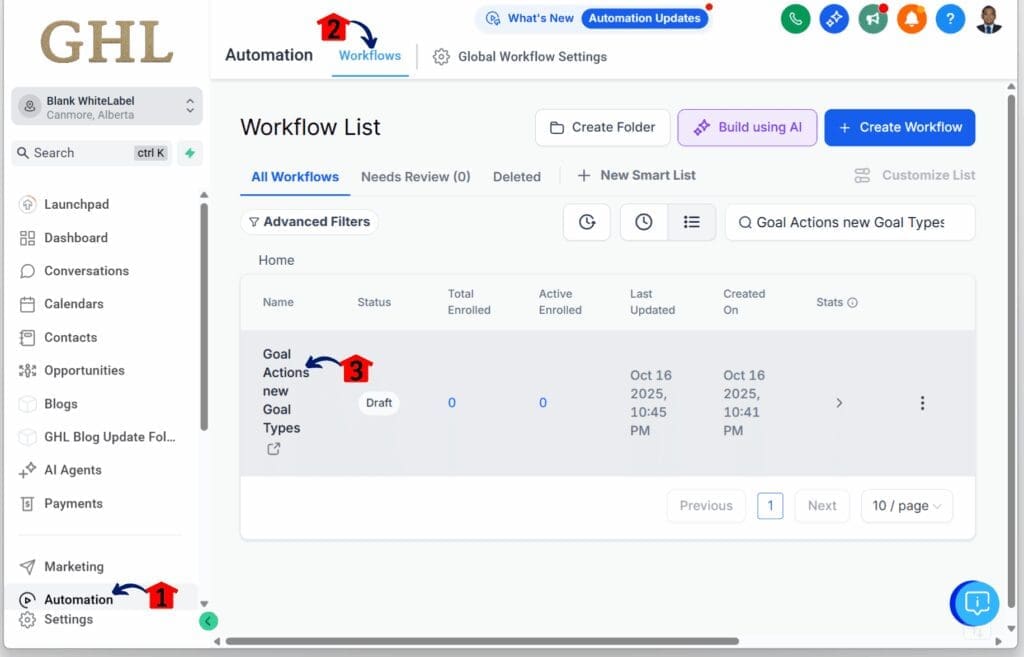
Step 02 – Edit the Workflow Goal Settings
- You’ll be directed to the workflow canvas, where you can edit and use the Workflow Goal Actions.
2.1 Click a Goal Event element.
- The goal event settings panel will slide in from the right.
2.2 Click the Select Type of Goal dropdown.
2.3 Check and confirm that the Payment Received, Form Submitted, and Document Status options appear.
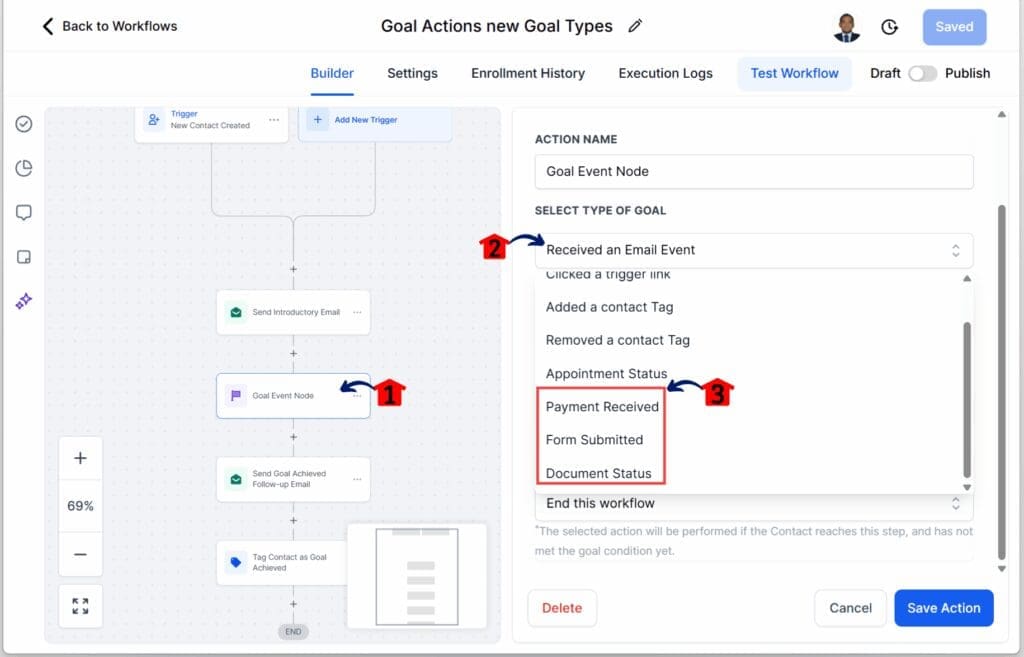
Step 03 – Configure the Payment Received Goal
- For this example, the Payment Received option is selected.
3.1 Choose the Payment Received goal type.
3.2 Configure the Payment Received action based on your marketing and business goals.
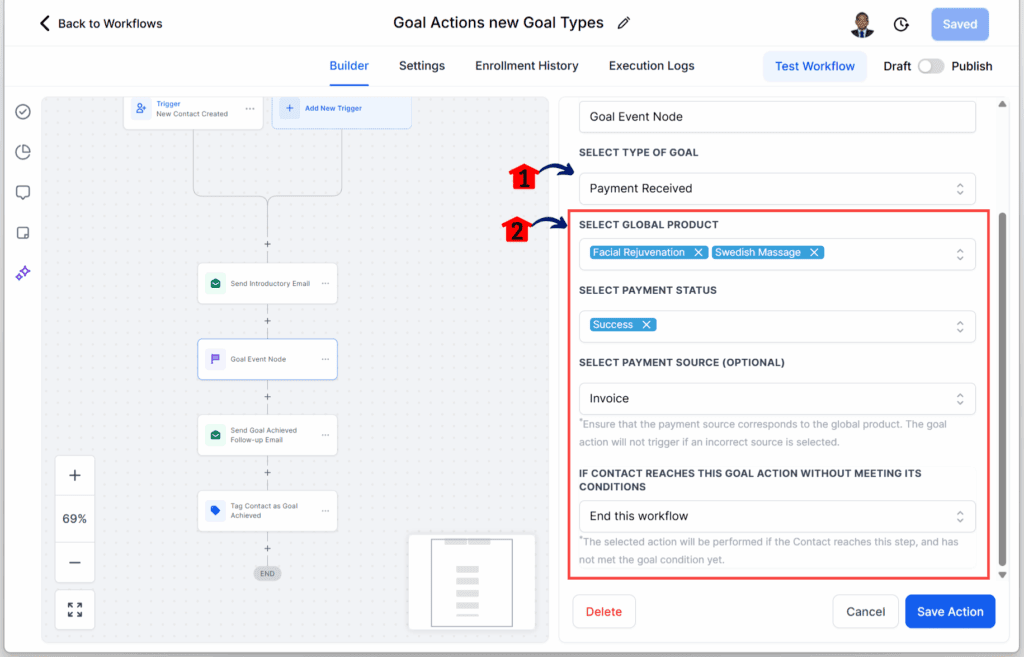
Step 04 – Configure the Form Submitted Goal
- For this example, the Form Submitted option is selected.
4.1 Choose the Form Submitted goal type.
4.2 Configure the Form Submitted action based on your marketing and business goals.
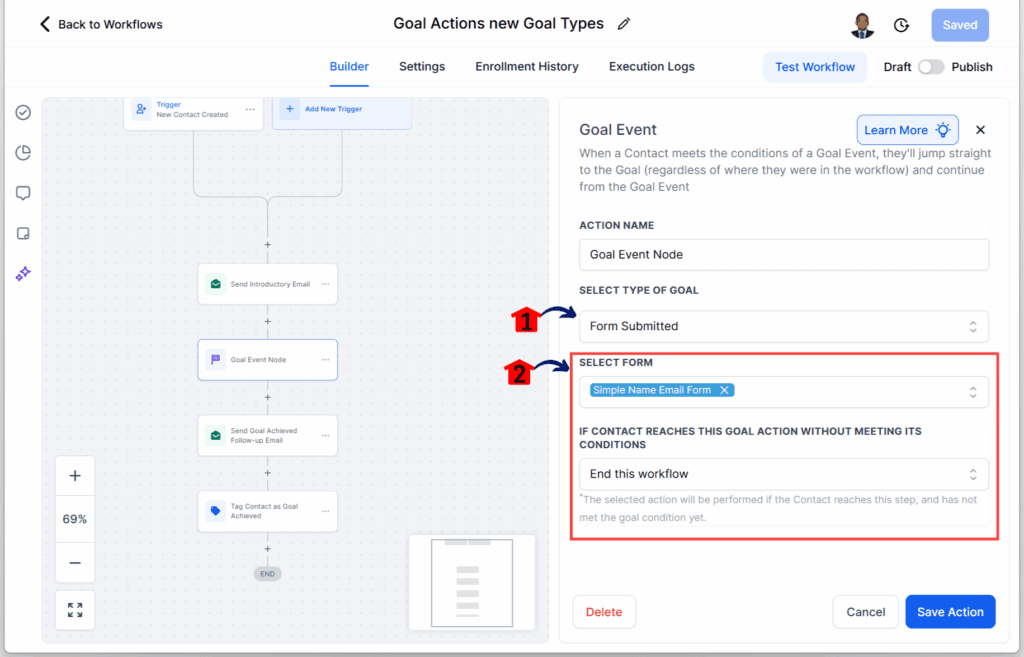
Step 05 – Configure the Document Status Goal
- For this example, the Document Status option is selected.
5.1 Choose the Document Status goal type.
5.2 Configure the Document Status action based on your marketing and business goals.
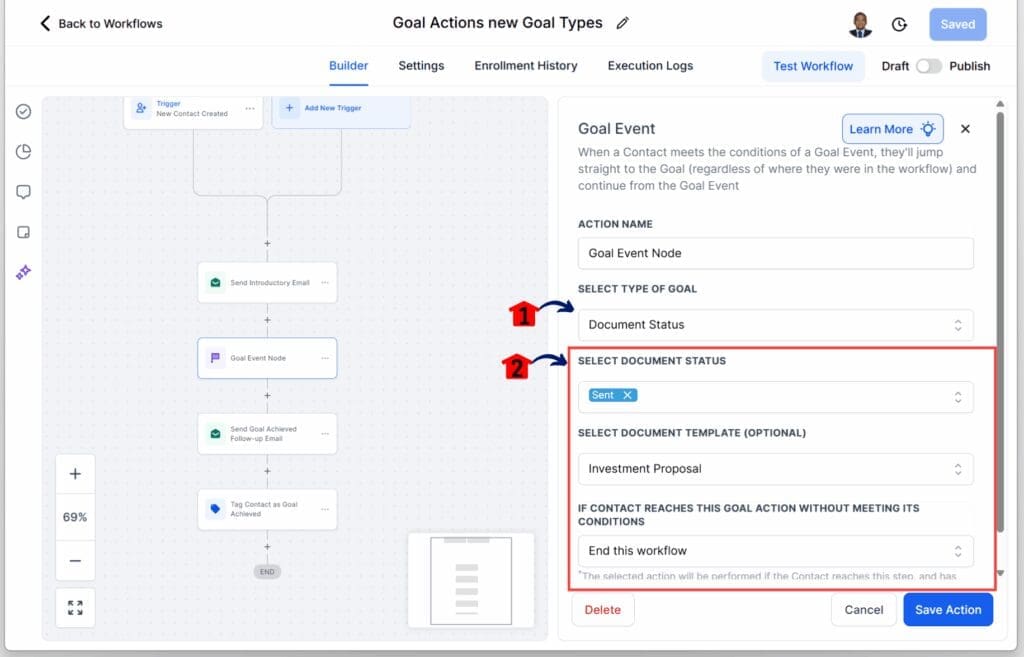
These workflow goal actions are built into the tools GHL users already know. No extra apps or workarounds are needed. Just a few clicks, and automation becomes a lot more connected to what clients are actually doing.
Real Examples Agencies Will Love
The new workflow goal actions are built for real-world situations. They help automate common tasks without extra filters, tags, or branching paths. Here are a few ways agencies are already putting them to work.
- Managing Multiple Lead Forms. Some agencies run several lead magnets at once. Instead of building a different workflow for each one, they use the multi-form goal. Now when someone submits any of the selected forms, the same follow-up kicks in. This keeps things simple and avoids having to copy the same logic over and over.
- Starting Onboarding After Payment. A service-based business wants to begin onboarding as soon as a client pays. They set up a payment-based goal that checks for the first successful transaction. Once it hits, the welcome emails and tasks go out right away. No waiting. No manual triggers.
- Following Up on Proposals. An agency sends out contracts and wants to check in when someone views a document but doesn’t sign it. With the document status goal, they can trigger a follow-up after 24 hours. It helps close deals faster without someone on the team needing to follow up manually.
- Catching Failed Payments Automatically. A subscription business wants to follow up when a card fails. They use the payment goal with a “failed” filter to alert the client and tag them for review. This keeps their billing process tight without depending on outside alerts.
These use cases all show how the new workflow goal actions can support better timing and fewer errors. Instead of reacting late, GHL users can now build workflows that follow what people are doing in real time.
Smarter Automation With Less Logic
These new workflow goal actions are simple to set up, but using them well takes a little planning. A few smart choices can make your workflows cleaner, faster, and easier to manage over time.
- Use goals instead of branches. If your workflow is packed with filters and condition steps, take a second look. A well-placed goal can often do the same job without all the extra logic. This keeps the workflow easier to follow and quicker to update when things change.
- Let goals track behavior, not tags. Instead of tagging contacts and using those tags to guide the next step, try using a goal. The system watches for the action to happen, whether it’s a form submission, a payment, or a signed document. Once it happens, the workflow moves forward. No tag needed.
- Spread out your goals. It’s okay to use more than one goal in a workflow. Some teams like to check for a form early on, a payment later, and then a signed contract before they wrap things up. Each goal keeps the process focused and avoids stacking too much into one step.
- Review filters before you go live. One of the easiest mistakes is picking the wrong form, document, or product when setting a filter. Before turning on the workflow, double-check each goal’s settings. Make sure it’s tracking the right thing.
With these small changes, teams can get more value from workflow goal actions without overthinking the setup. The best workflows are simple, clear, and focused on what the contact actually does.
Better Automation, Less Chaos
Most workflow problems come from trying to do too much with too many steps. The new workflow goal actions in GHL help fix that by letting the system track real actions without extra filters or workarounds.
Instead of building different branches for each form, payment, or document, users can now set one clear goal. When the action happens, the contact moves forward. It works in the background and keeps the workflow easy to follow.
This is especially helpful for agencies that handle a lot of clients or projects. Simple workflows are easier to copy, easier to update, and easier for team members to understand. When things are built with less logic, they break less often and take less time to manage.
These workflow goal actions also make follow-ups more accurate. Since the system is checking for specific actions like form submissions or signed contracts, there is less waiting and guessing. Contacts move forward as soon as they are ready, without delay.
In the end, this update helps teams focus on building smart systems instead of just stacking steps. The goal feature is not just cleaner, it also keeps the focus on what matters most, what the contact is actually doing.
Common Questions About Workflow Goal Actions
The updated workflow goal actions are easy to use, but some users still have questions. Here are a few common ones, answered clearly and without the fluff.
This update takes some of the guesswork out of automation. When teams understand how goals work, they can build smoother workflows that respond to real actions.
What You Can Expect After This Update
The updated workflow goal actions in GHL help teams work smarter. They remove extra steps and let workflows respond based on what contacts actually do. Here’s what users can expect after putting them in place.
- Simpler workflows. Fewer branches and cleaner logic make a big difference. When workflows are easy to read, they are easier to fix, share, and improve. This helps teams move faster and avoid costly mistakes.
- Better timing. These goal actions run as soon as a contact completes the right action. That could be submitting a form, making a payment, or signing a document. There is no need to guess when to move them forward.
- More reliable automation. Because goals track specific behavior, there is less room for error. The system is not waiting on tags or custom triggers. It follows real actions and responds without extra steps.
- Easier for teams to manage. Clean workflows are easier to hand off, even between accounts or teams. When someone looks at a workflow and clearly sees the goal, they can understand what it’s doing without guessing.
Agencies that build around these new workflow goal actions will spend less time fixing problems and more time helping clients. The update might look small, but it leads to stronger systems and better results.
Try These New Workflow Goal Actions Today
The latest GHL update brings a simple but useful upgrade to the workflow builder. With the new workflow goal actions, users can track the moments that matter, like when someone fills out a form, makes a payment, or signs a document.
This gives agencies more control without adding more complexity. Instead of stacking branches or using extra filters, teams can set clear goals and let the system handle the timing. It keeps workflows easy to understand and easier to scale.
If a current workflow feels too heavy or hard to follow, this update may be the fix. A single goal can often do the work of several steps. That means fewer mistakes and less time spent on cleanup later.
This feature is already live. It works with forms, payments, and documents that users are already managing inside GHL. There is nothing new to buy or install.
Try it out in a live workflow. Use a form goal to clean up an opt-in flow, or set a payment goal to improve onboarding. These small changes can help teams build better systems without starting from scratch.
Scale Your Business Today.
Streamline your workflow with GoHighLevel’s powerful tools.
